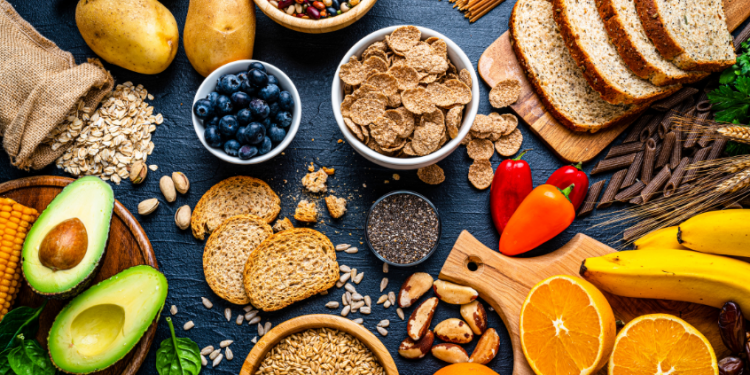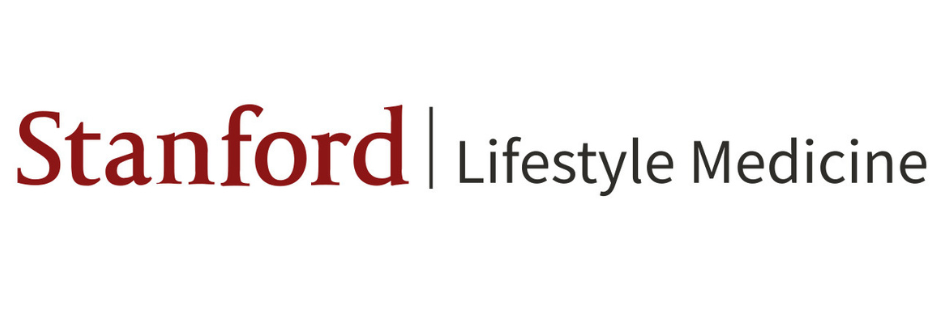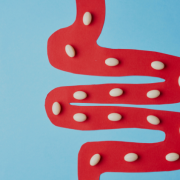What is Fiber and Why is it Important for the Microbiome?

Key Takeaways:
- Fiber promotes a healthy microbiome by feeding the “good” bacteria in the gastrointestinal tract.
- Fiber is not broken down by the digestive organs but instead passes through the body to support healthy bowel movements.
- 95% of Americans are deficient in fiber.
- 19-38 grams of fiber per day is recommended and should be added to every meal.
- Fiber is found in plant-based foods, particularly beans, nuts, fruits, and vegetables.
- Fiber has many health benefits, including reducing risk of cardiovascular disease, type 2 diabetes, and several cancers.
Fiber not only helps us stay regular, but it also supports a healthy gut microbiome, which is crucial for overall health. Studies show that getting enough fiber strengthens the immune system, supports gut health, reduces inflammation and risk for heart disease, stroke, hypertension, obesity, Type 2 diabetes, and several cancers, including colon and breast cancer.
Although the Institute of Medicine recommends consuming 19-38 grams of fiber per day, national surveys show that 95 percent of Americans don’t consume enough fiber in their diets.
“The biggest thing I’ve learned in my nutrition research is that it’s very rare for people to consume sufficient fiber,” says Jessica Hope, Nurse Practitioner, and member of the Stanford Lifestyle Medicine nutrition pillar. “As a country, we aren’t deficient in protein; we are deficient in fiber. We need to spread awareness about this problem.”
What is Fiber, and What Does it Do?
Fiber is a type of carbohydrate that serves as a prebiotic, or food for the “good” bacteria in the gut, promoting a healthy microbiome. Also, rather than being broken down by digestive organs, fiber passes through the body to support healthy bowel movements. There are two types of fiber: soluble and insoluble.
Soluble Fiber
Soluble fiber dissolves in water and creates a gel-like substance that slows the movement of food through the digestive tract. This slower digestion reduces blood sugar spikes, lowers blood cholesterol, and helps you to feel fuller longer.
Best food sources of soluble fiber include:
- Legumes: Beans of all kinds, including kidney, black, pinto, white, lima, navy, chickpea; edamame; and peas
- Oats
- Tofu
- Avocado
- Brussels sprouts
- Sweet potatoes
- Broccoli
- Pumpkin
Insoluble Fiber
Insoluble fiber (aka roughage) is found in the skin and structure of fruits and vegetables—it’s what makes these foods crunchy. Instead of dissolving in water, insoluble fiber attracts water into the stool, making it softer and easier to move through the digestive system. This promotes bowel-movement regularity and prevents constipation and hemorrhoids. Also, since these crunchy foods require more chewing, it takes longer to eat a fiber-rich meal, slowing down digestion and helping with portion control.
Best food sources of insoluble fiber include:
- Whole wheat products, like 100% wholewheat bread and pasta
- Oat bran and oatmeal
- Legumes: Beans of all kinds, including kidney, black, pinto, white, lima, navy, chickpea; edamame; and peas
- Berries: including blackberries, blueberries, raspberries, strawberries
- Whole grains, including quinoa, rye, barley, amaranth, brown rice
- Leafy greens, like kale and spinach
- Vegetables, like broccoli, okra, radishes
- Nuts, especially almonds and walnuts
- Fruits with edible skins, like pears and apples
- Avocados
- Sunflower, flax, and chia seeds
- Potatoes and sweet potatoes
- Popcorn
Many plant-based foods offer both types of fiber. For example, the flesh of an apple has soluble fiber, and the skin contains insoluble fiber. Legumes and beans also offer both types of fiber.
“Grains don’t carry as many micronutrients as fruits, vegetables, nuts, or seeds,” says Hope. “There’s nothing wrong with getting your fiber from whole grains, they just don’t pack as much of a nutritional punch.”
Health Benefits of Fiber
Consuming adequate amounts of fiber is associated with a host of health benefits and disease prevention, such as:
Cardiovascular Health
Many studies show that beta-glucan, a soluble fiber found in oat and barley foods (such as cereals), reduces the amount of cholesterol in the blood. Lower cholesterol reduces the risks of atherosclerosis (hardening of the arteries) and high blood pressure.
Type 2 Diabetes
Soluble fiber (including beta-glucan) also slows down digestion and reduces sugar absorption into the bloodstream, which lowers overall body weight and the risk for type 2 diabetes.
“Americans eat so few beans compared to other cultures. I think that one of the reasons why we have more heart disease and diabetes in our country is because we don’t have many beans as a traditional part of our diet,” says Hope.
Microbiome Health and Stronger Immune System
The gut microbiome is the community of microorganisms found in the small and large intestine of the digestive tract. Fiber serves as a prebiotic, meaning it feeds the microbiota or “good” bacteria in the large intestine, allowing it to flourish and take up space. This strengthens the immune system in that all bacteria compete for surface area on the gut lining, so if enough space is occupied by “good” bacteria, the “bad” bacteria won’t have room to grow.
Also, when our microbiota consume fiber in the large intestine, they release acids that keep the colon healthy, such as short-chain fatty acid, butyric acid, acetic acid, and propionic acid.
“Microbiota in our gut need to eat just like we do, and when we eat, we are also feeding them. If we don’t feed them enough fiber, they will look around to see what else they can eat. Recent research is pointing toward the possibility that the circumstance referred to as ‘leaky gut’ occurs when microbiota are so starved they begin to eat the lining of our own intestine,” says Hope. “Of all the reasons to eat a lot of fiber, this is the main one for me.”
Anti-inflammation and Anti-Cancer Effects
Research also shows that fiber-rich foods reduce inflammation. One study showed barley increased the amount of butyric acid-producing bacteria in the gut, which is known to suppress excessive inflammatory responses.
Butyric acid has been shown to prevent the development of chronic disease and inhibit tumor cell proliferation, reducing the risk of several cancers, including colon, breast, esophageal, lung, and liver cancer.
Fiber and Longevity
In this epidemiologic study, there is a clear association between fiber consumption and reduction in all-cause mortality. The study shows that among those who consume between 20 to 30 grams of fiber per day, which is the recommended amount, there is a 10 to 20 percent reduction in death from any cause.
Easy Ways to Add Fiber to Your Diet
You can find fiber in most whole or minimally processed plant-based foods, including beans, whole grains, nuts, seeds, fruits, and vegetables.
Easy-to-make, fiber-rich meals:
- Breakfast – berries with whole grain cereal or oatmeal; avocado toast on whole-grain bread
- Lunch – leafy-green salad with beans or lentils and avocado
- Snack – popcorn, whole fruit (eat the skin if possible), nuts (almonds, walnuts)
- Dinner – quinoa or brown rice with sweet potatoes, broccoli, asparagus, carrots, and/or Brussels sprouts
- Dessert – pumpkin pie
Tips to get more fiber in your diet:
- Eat whole fruits and vegetables instead of juicing—the pulp is the fiber!
- Swap white rice, pasta, and bread with their brown or 100% wholewheat counterparts.
- For protein, swap animal products, which contain no fiber, with beans and tofu.
- If you find fresh produce spoils too quickly, frozen fruits and vegetables are just as nutritious.
- Fiber supplements (such as ones with psyllium husk) help regulate bowel movements but don’t promote a healthy microbiome because they don’t feed the “good” bacteria. Therefore, it is recommended to consume daily fiber intake from food sources rather than supplements.
How to Prevent Gas and Bloating from Eating Fiber
The microbiome is comprised of different kinds of bacteria that eat different types of fibrous foods. For example, some bacteria specifically digest black beans, other bacteria digest oats, while other bacteria digest kale. Hope explains that if someone who doesn’t eat black beans frequently suddenly consumes 25 grams of black beans in one day, they won’t have enough black-bean digesting bacteria in their gut, resulting in gas and bloating.
“To prevent gas and bloating, the keys are to drink lots of water and start slow when incorporating more fiber into your diet. The amount of fiber we eat should be just slightly more than the bacteria we already have in our guts are asking for,” says Hope. “People often say things like, ‘black beans don’t agree with me’ but that isn’t the case. They just don’t have enough of the bacteria that digest those beans. Rather than avoid black beans, they can incorporate them slowly into their diets, allowing time for that specific bacteria to multiply.”
Along with starting small to prevent digestive discomfort, Hope suggests experimenting with easy ways to increase the fiber of every single meal to make the habit sustainable. For example, this can be achieved by adding berries to your breakfast, beans to your lunch, and vegetables to your dinner.
According to research, if all Americans increased their fiber intake by 10 grams per day, the reduction in all-cause mortality would be profound, and everyone would be a little bit healthier.
“Along with being essential for your health, fibrous foods are delicious!,” says Hope. “The best way to increase fiber in your diet is to choose foods that you enjoy and add them, little by little, throughout the day. So, if you don’t like beans, perhaps you could start with apples and blueberries, and shop and plan to make these your go-to snack or dessert to develop this healthy habit.”







